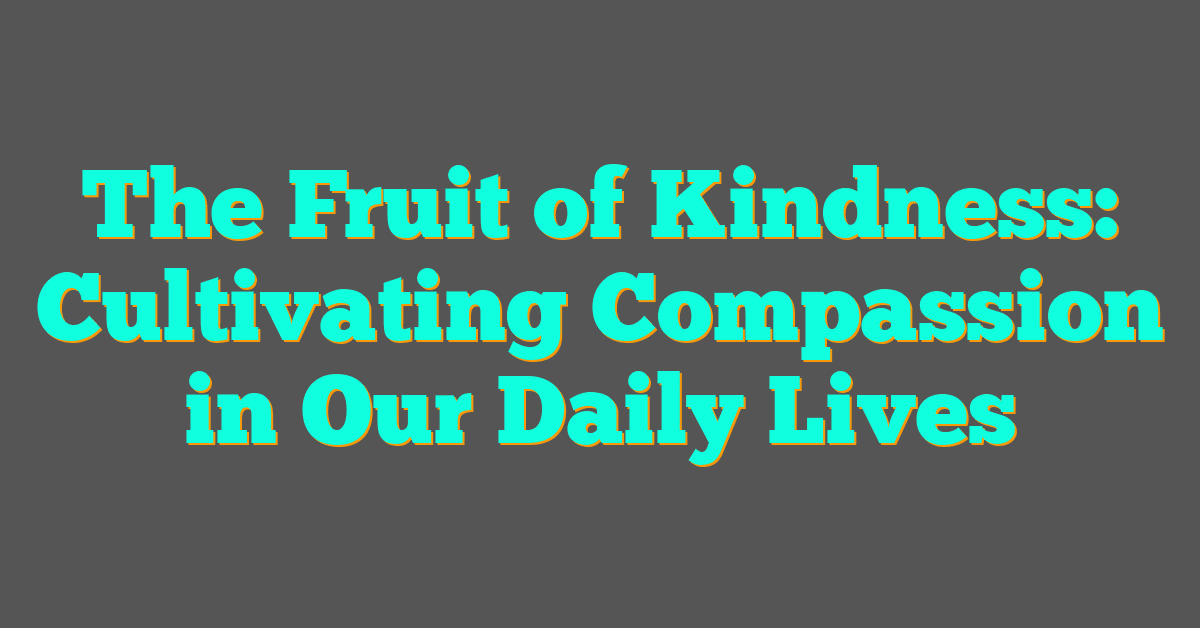Kindness is more than just a simple act; it is a powerful way to show love and compassion toward others. In a world where people often rush by, taking the time to be kind can create meaningful connections.
When individuals embody the fruit of kindness, they reflect a deeper understanding of love and compassion that can change lives.

Everyday moments present opportunities to practice kindness. Whether it’s a smile, a helping hand, or words of encouragement, these small gestures can significantly impact someone’s day.

By nurturing a kind and tenderhearted attitude, people can build a community filled with support and warmth.
As kindness spreads, it creates a ripple effect that benefits everyone. This article explores how individuals can manifest kindness in their lives, showing that even the simplest actions can lead to a more compassionate world.
Key Takeaways
- Kindness is a reflection of love and can transform relationships.
- Small acts of compassion can create significant social impacts.
- Fostering kindness can inspire future generations to share and care.
Understanding Kindness in Christianity
Kindness holds a significant place in Christianity, reflecting God’s love and the teachings of Jesus. It is seen as a vital Christian virtue and is deeply rooted in scripture. This section explores the biblical foundations of kindness, the role of the Holy Spirit in fostering it, and how it is expressed as a fruit of the Spirit.
Biblical Foundations of Kindness
The Bible presents kindness as a core principle of Christian living. In the New Testament, Paul emphasizes kindness in his letters, particularly in Galatians 5:22-23, where kindness is listed as part of the fruit of the Spirit.
Biblical kindness is more than just being nice; it is a deliberate action that reflects God’s character. For instance, Ephesians 4:32 encourages believers to “be kind to one another, tenderhearted, forgiving one another.” This highlights that kindness involves compassion and forgiveness, demonstrating love in tangible ways.
The Role of the Holy Spirit
The Holy Spirit plays a crucial role in developing kindness within believers. Through spiritual growth, the Holy Spirit transforms hearts, allowing individuals to act generously and compassionately toward others.
When someone submits to the guidance of the Holy Spirit, their ability to show kindness increases. This transformation enables them to respond to others’ needs in ways that align with God’s will. As the Spirit works within, believers become vessels of God’s kindness, extending grace to those around them.
Fruit of the Spirit: A Christian Perspective
Kindness is a key aspect of the fruit of the Spirit, as noted in Galatians. The fruit of the Spirit includes love, joy, peace, and kindness, among others. Each aspect builds upon the others, creating a well-rounded Christian character.
Paul teaches that cultivating the fruit of the Spirit leads to a life that reflects Jesus’ teachings. By practicing kindness, believers not only follow scriptural mandates but also exemplify God’s love to the world. Each act of kindness serves as an invitation for others to experience the love of Christ through their actions.
Manifesting Kindness in Daily Life

Kindness can be shown in many ways. The following sections explore how acts of kindness, patience in relationships, and the importance of forgiveness can help manifest kindness in daily life.
Acts of Kindness and Generosity
Small acts of kindness can have a big impact. Holding the door for someone or offering a compliment can brighten someone’s day.
Being generous with time and resources is also important. Volunteering at a local charity or helping a neighbor can make a difference.
Here are some simple acts of kindness people can practice:
- Pay for someone’s coffee: A small gesture can spread joy.
- Leave a positive note: A message left for someone can lift their spirits.
- Donate items: Giving clothes or toys can help those in need.
These acts remind others that they are cared for, encouraging kindness in return.
Patience and Understanding in Relationships
In every relationship, patience is vital. Taking time to listen shows respect and understanding.
When disagreements occur, remaining calm can lead to better outcomes. Responding instead of reacting helps maintain harmony.
Here’s how patience can be demonstrated:
- Active listening: Give full attention when others speak.
- Take breaks: If tensions rise, stepping away can prevent conflicts.
- Practice empathy: Trying to understand another person’s feelings fosters connection.
Patience nurtures kindness and strengthens bonds.
The Power of Forgiveness and Mercy

Forgiveness is a profound act of kindness. Letting go of grudges frees individuals from negativity.
Mercy involves showing compassion, even when it’s difficult. It helps heal wounds and build trust.
Practicing forgiveness can include:
- Reflecting on feelings: Acknowledge hurt but focus on healing.
- Communicating openly: Talking about issues can mend relationships.
- Choosing to move forward: Making the decision to forgive is powerful.
These actions encourage a culture of compassion and kindness, enriching lives.
Examples of Compassion

Compassion can take many forms, from timeless stories to modern acts of kindness. These examples show how kindness can transform lives and teach important lessons about caring for others.
Parable of the Good Samaritan
The Parable of the Good Samaritan is a well-known story from the Bible that illustrates compassion in action. In this parable, a man is attacked and left injured on the road. While others pass by without helping, a Samaritan stops to assist him.
The Samaritan bandages the man’s wounds and takes him to an inn for care. This story highlights the importance of showing kindness and compassion regardless of background or beliefs. It reminds readers that true compassion is about action, not just words.
In doing so, the Good Samaritan teaches that everyone is worthy of help and love. This parable encourages individuals to act kindly towards others, even strangers.
Modern Examples of Christian Kindness
Modern Christian kindness can be seen in countless acts of compassion today. Many Christian organizations provide meals, clothing, or shelter to those in need. These acts address poverty and show God’s love in practical ways.

Volunteers often organize community service events. Whether it is cleaning up local parks or visiting nursing homes, these efforts foster connections and build relationships. Even small acts, like a warm smile or a listening ear, can make a big difference.
Church groups frequently come together for outreach programs. They may help local families through tough times or provide support after natural disasters. These situations demonstrate that kindness and compassion are alive today, just as in the story of the Good Samaritan.
Cultivating a Kind and Tenderhearted Attitude
Creating a kind and tenderhearted attitude involves embracing gentleness and humility. It also requires learning how to resolve conflicts without seeking revenge. These qualities can greatly enhance relationships and foster a compassionate environment.
Tenderness and Humility
Being tenderhearted means approaching others with compassion and care. This attitude encourages people to treat one another with gentleness. When individuals practice humility, they recognize their own flaws and the importance of supporting others through their challenges.

To cultivate tenderness and humility, one can:
- Listen actively to others without interrupting.
- Reflect on personal experiences that inspire empathy.
- Practice gratitude for the kindness shown by others.
These steps help create a nurturing atmosphere where forgiveness is valued, and slander is avoided. Having a heart full of kindness not only uplifts others but strengthens one’s own spirit.
Conflict Resolution Without Revenge
Conflicts are a part of life, but how they are handled is crucial. Choosing to resolve conflicts without revenge is a sign of true strength. Instead of reacting with anger, a tenderhearted approach seeks understanding and forgiveness.
Effective strategies include:
- Open dialogue to express feelings honestly.
- Finding common ground to rebuild trust.
- Letting go of grudges to promote healing.
By focusing on these methods, individuals can prevent the cycle of hurt and negativity. This fosters a more peaceful community where kindness thrives.
Kindness as a Reflection of God’s Nature

Kindness mirrors God’s character and shows his deep love for humanity. It reveals his virtue through grace and favor, inviting people to act with compassion toward one another.
Grace and Favor as Expressions of Kindness
Grace is an important part of God’s kindness. It means giving something good that people do not deserve. This aligns with the idea of being generous and forgiving.
When God’s kindness is shown, it creates a space for people to feel safe and cherished. It encourages acts of love within communities.
Favor, as another aspect of kindness, highlights God’s willingness to bless. When individuals show favor, they uplift others and create bonds of trust and support.

Together, grace and favor encourage kindness that strengthens relationships and builds a more compassionate world. This type of kindness stems from a greater understanding of how to care for one another.
The Social Impact of Kindness
Kindness plays a vital role in shaping communities. It fosters a sense of peace and joy while addressing the needs of others. Acts of kindness create a ripple effect that encourages giving and sharing, making lives better for everyone.
Promoting Peace and Joy in Communities
When kindness is spread throughout a community, it has the power to create a peaceful environment. Friendly gestures, like smiling at strangers or helping a neighbor, can lift spirits. These small acts build connections among people.
In a connected community, joy increases. People feel supported and recognized, which helps reduce stress. For example, community events that encourage sharing can boost happiness. When kindness is prioritized, overall well-being flourishes.
The Role of Kindness in Meeting Others’ Needs

Acts of kindness directly address the needs of others. Whether it’s providing food to someone in need or lending a listening ear, being considerate can change lives.
Compassionate people are more likely to notice when others are struggling.
By giving time and resources, individuals meet various needs in their community. They help those who may be facing challenges like loneliness or hunger.
Moreover, kindness encourages others to pay it forward, creating a cycle of support. This collective effort strengthens bonds and fosters a caring atmosphere.
Fostering Kindness in the Next Generation

Teaching children to be kind is essential for building a compassionate society. By guiding them on how to show empathy and support, adults can inspire future generations to foster goodwill and make positive choices.
Teaching Kindness to Children
One effective way to teach kindness is through example. Children learn from observing the adults around them.
When parents and teachers model acts of kindness, kids are more likely to mimic these behaviors.
Activities to Encourage Kindness:
- Volunteer Together: Participating in community service helps children see the impact of their kindness.
- Teach Empathy: Discuss feelings and ask how others might feel in different situations.
- Reward Kind Actions: Praise and recognize kind acts to reinforce positive behavior.
Incorporating themes of faithfulness and goodness can also help. Sharing stories that highlight these values can inspire children.
Additionally, practicing self-control is crucial in teaching patience and understanding in difficult situations.
Conclusion
Kindness is a beautiful expression of love and compassion. It goes beyond just being nice. It is about truly caring for others and understanding their needs.
When someone shows kindness, it can make a huge difference in someone’s life. This act not only uplifts others but also strengthens one’s faith. Kindness brings people closer together.
In daily life, small acts of kindness can have a powerful impact.
It could be a simple smile, a helping hand, or listening to someone in need. These actions can encourage a sense of community and support.
Moreover, kindness can inspire others to act similarly. It creates a ripple effect, spreading love and compassion. When people witness kindness, they are more likely to pay it forward.
Embracing kindness enriches our lives and the lives of those around us. It is a vital part of building a better world, where everyone feels valued and cared for. By practicing kindness, individuals contribute to a more compassionate and connected society.
















